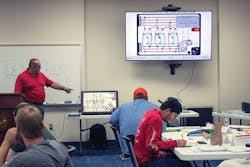When apprentice linemen step out into the line trade, utilities may ask them to build a transformer bank. If this job is performed incorrectly and they perform one wrong connection, they could inflict thousands of dollars of damage and put their livelihood, and even their lives, at risk.
To train linemen how to do this work method the right way, ElectriCities of North Carolina invited municipal linemen from across the state of North Carolina to a one-week Transformer Training School in Maiden, North Carolina, last summer.
Rather than making the linemen sit in the classroom all day and learn from textbooks, the school introduced the students to a new way of learning. Because linemen often prefer to perform physical, hands-on work, the school not only taught the students through classroom instruction, but also gave them the opportunity to practice on a simulator and work on transformers in a training yard.
Training Municipal Linemen
Once or twice a year, ElectriCities offers a Transformer Training School for students—alternating one in the eastern part of the state and one in the West to make it convenient for cities across North Carolina to send their employees. Since each class is limited to 25 students, a second school is sometimes added, but typically, only one course is offered per year.
These training programs are designed not only for the apprentices new to the line trade, but also for experienced journeymen linemen who need refresher training. On the first day of the training program, the students took a verbal pre-test assessment and attended a job briefing before learning about transformer theory and touring the outside facilities.
The next day, the linemen received instruction on IFD and single-phase transformer installation replacement and removal. During the week, they also learned how to size a transformer and troubleshoot an overhead transformer bank following a simulated outage.
To give its students real-world experience with transformers, ElectriCities of North Carolina introduced the new Load Trainer II Transformer Simulator from Utility Solutions at its summer session. The portable three-phase trainer takes classroom learning a step beyond basic textbooks and slide presentations by combining a physical wiring environment with a computer controlled simulation.
Operating the Simulator
The Transformer Simulator, which measures 27.5-in. wide by 19 in. tall by 3.5 in. deep, weighs 16 pounds. It also includes color-coded patch cords and a 7-in. interactive touch screen. To operate the simulator, users apply jumpers between source lines, transformers and a secondary system. When they press the “test” button, the simulator will display phase-to-phase voltages, phase-to-neutral voltages, phase angles and load.
The simulator demonstrates wye, delta, polarity, phase rotation and phase angles, and it allows trainers to introduce faults on both the primary and secondary, modify phase orientation, and explore multiple secondary voltages and different transformer settings. To allow linemen to practice real-world troubleshooting, the instructors can simulate back-feeding and reduced capacity services.
In the classroom, the linemen can wire up the simulators, check the rotation on the secondary side and use their voltmeters before performing work on actual transformers in the training yard. Because they are engaged in this immersive learning method, they are more likely to retain the knowledge when they return to the field.
While many linemen don’t build transformer banks every day—especially if they work at a smaller municipality—they often need to take the classes every five to 10 years. As new customers move into North Carolina, more transformer banks will need to be constructed, reinforcing the need to learn how to safely build transformer banks the right way.
Gaining Real-World Experience
Before ElectriCities had access to the simulators, the instructors had the students draw the transformer banks on paper at their desks. They then came up to the white boards and worked in teams of five to draw out the entire bank before going outside to wire up the transformers.
With the simulator, however, they can work with “live” voltage, measure the real-world voltage of the transformers and learn what it takes to build the bank, which builds their confidence when they work in the field.
Rather than drawing schematics on the whiteboard, the instructors can hook the simulator to a monitor or projector to display the simulation on a big-screen TV. That way, they can show the students the right and wrong way to build a transformer bank.
If a student gets their wires crossed on the simulator, it is a learning experience, but it they make a mistake in the field, they could get hurt or killed. For example, if there is a fault on a transformer, enough pressure can build up inside of it that the lid can blow off and scatter hot oil. The transformer simulator, however, allows linemen to learn in a safe, controlled environment. That way, the next time they need to build a transformer bank, they can take the risk out of this work method.




